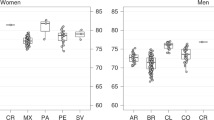Abstract
STANDARDISED death rates in the US, due to ischaemic heart disease stopped increasing and began to decrease during the period in which large numbers of cities began fluoridating their water supplies but no notice has been taken of this effect. Gordon and Thom1 note that deaths attributable to ischaemic heart disease had been increasing until about 1960. By 1968, a clear decrease had begun, and continued until their last observations in 1972. They felt that this decrease (7.3%) could be partially explained on the basis of less severe influenza epidemics, which are thought to increase the mortality rates due to heart disease in the winter months. However, artificial fluoridation was started in 1952, and by 1969 had covered 74 million people2. Therefore, the possibility exists that fluoridation might be involved in the declining rates. Ideally, this would be checked by comparing the rates for ischaemic heart disease between fluoridated and non-fluoridated populations. The largest political units in which the distinction between fluoridated and non-fluoridated populations is clear-cut are cities; unfortunately, ischaemic heart disease is not tabulated separately for cities in the Vital Statistics publication. Ischaemic heart disease is an important part of the category ‘all heart disease’, and those data are readily available. We report here on changes in the more inclusive category (all heart disease) and fluoridation status, which support the possibility that fluoridation is associated with the decreasing rates.
This is a preview of subscription content, access via your institution
Access options
Subscribe to this journal
Receive 51 print issues and online access
$199.00 per year
only $3.90 per issue
Buy this article
- Purchase on Springer Link
- Instant access to full article PDF
Prices may be subject to local taxes which are calculated during checkout
Similar content being viewed by others
References
Gordon, T. & Thom, T. Preventive Med. 4, 115–125 (1975).
WHO Chron. 23, 505 (1969); Fluoride Teeth and Health (Royal College of Physicians, 1977).
Taves, D. R. Cold Spring Harb. Symp. quant. Biol. (in the press).
Yiamouyiannis, J. & Burk, D. Fluoride 10, 102–125 (1977).
Doll, R. & Kinlen, I. Lancet i, 1300 (1977).
Oldham, P. D. & Newell, D. J. Appl. Statist. 26, 125–135 (1977).
Burk, D. & Yiamouyiannis, J. Congressional Rec. (21 July and 16 December 1975).
Vital and Health Statistics Series 20, No. 16 (Natn. Cent. Hlth Statist. 1974).
Bonte, F. J., Parkey, R. W., Graham, K. D., Moore, J. & Stokely, E. M. Radiology 110, 473–474 (1974).
Taves, D. R. & Neuman, W. F. Archs Biochem. Biophys. 108, 390–397 (1964).
Zipkin, I. et al. Calcif. Tissue Res. 6, 173–182 (1970).
Bernstein, D. S. et al. J. Am. med. Ass. 198, 499 (1966).
Author information
Authors and Affiliations
Rights and permissions
About this article
Cite this article
TAVES, D. Fluoridation and mortality due to heart disease. Nature 272, 361–362 (1978). https://doi.org/10.1038/272361a0
Received:
Accepted:
Published:
Issue Date:
DOI: https://doi.org/10.1038/272361a0
Comments
By submitting a comment you agree to abide by our Terms and Community Guidelines. If you find something abusive or that does not comply with our terms or guidelines please flag it as inappropriate.



